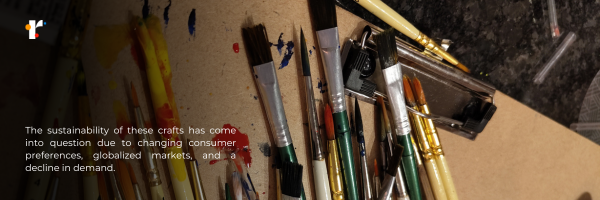In a world of rapid modernization and globalization, the preservation of traditional art and craft holds the key to maintaining cultural diversity and fostering sustainable development. These artistic expressions not only reflect the rich heritage of communities but also provide economic opportunities for artisans across the globe. However, as we strive to achieve the United Nations’ Sustainable Development Goals (SDGs), it is essential to recognize and address the challenges faced by the traditional art and craft sector.
The traditional art and craft of India exemplify the country’s diverse cultural identity, with each region boasting its unique artistic heritage. From intricate embroidery work in Lucknow to vibrant handloom textiles in Varanasi, and from intricate miniature paintings in Rajasthan to delicate terracotta pottery in West Bengal, the diversity of traditional art forms is astounding.

Collaboration with Government and NGOs
To preserve and promote traditional art and craft, partnerships for the goals play a crucial role. Collaborations among governments, NGOs, private sector organizations, and artisans themselves can create an enabling environment that supports innovation, inclusivity, and economic growth. Governments can develop supportive policies, recognize the value of traditional knowledge, and protect the rights and welfare of artisans. NGOs can implement capacity-building initiatives and advocate for the rights of artisans, amplifying their voices in decision-making processes.
Contribution from the Private Sector
Private sector organizations can contribute by embracing sustainable business practices, creating market opportunities for artisans, and integrating their products into responsible supply chains. Artisans themselves play a pivotal role in the success of partnerships, contributing their expertise, experiences, and perspectives to collaborative efforts.
A key aspect of promoting climate action in traditional art and craft is the use of renewable materials.

Role of Cultural Tourism
Cultural tourism also plays a crucial role in supporting sustainable communities. By attracting tourists interested in experiencing local art and craft traditions, communities can generate economic opportunities while preserving their cultural heritage.

In India, organizations like Rooftop are actively engaged in promoting sustainable development in the traditional art and craft sector. By creating fair-trade markets, organizing exhibitions, advocating for the implementation of sustainable livelihood frameworks, and encouraging women’s participation, Rooftop is fostering an inclusive and empowering environment for artisans.
As we look towards the future, it is vital to recognize that traditional art and craft are not merely relics of the past but valuable assets that contribute to our shared cultural heritage and sustainable development. By nurturing these artistic traditions through collaborative partnerships, responsible consumption, and environmental consciousness, we can ensure that traditional art and craft continue to thrive and enrich our lives for generations to come. Let us unite in our efforts to empower artisans and preserve their craft, creating a world where culture and sustainability go hand in hand.